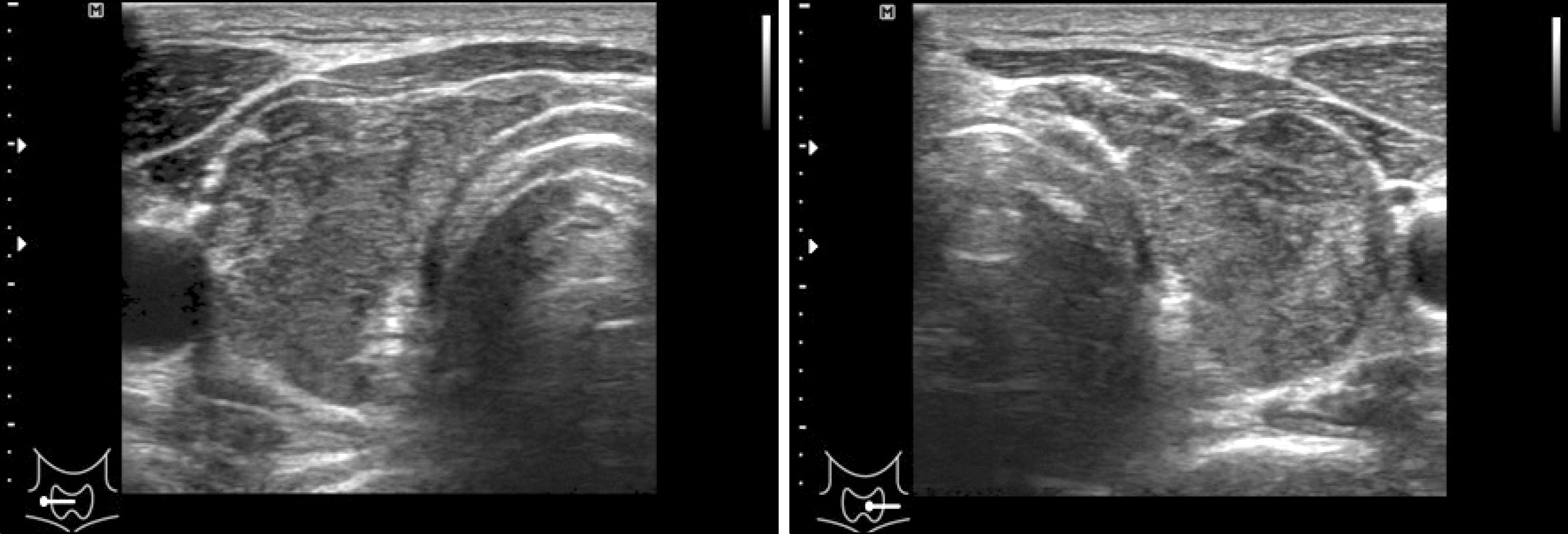Int J Thyroidol.
2016 Nov;9(2):200-203. 10.11106/ijt.2016.9.2.200.
Thyroid Associated Ophthalomopathy in a Patient with Hashimoto's Thyroiditis
- Affiliations
-
- 1Department of Endocrinology, Soonchunhyang University College of Medicine, Cheonan, Korea. yeojoo@schmc.ac.kr
- 2Department of Endocrinology, Good Morning Hospital, Pyeongtaek, Korea.
- KMID: 2362359
- DOI: http://doi.org/10.11106/ijt.2016.9.2.200
Abstract
- A 53-year-old man consulted an ophthalmologist with a chief complaint of diplopia and bilateral eyelid swelling. He was diagnosed with hypothyroidism 2 years prior at a local clinic and had been taking levothyroxine 150 mcg daily. CT scan of the orbits showed enlargement of bilateral extraocular muscles. Laboratory findings revealed hyperthyroidism due to high dose levothyroxine. Active ophthalmopathy with Hashimoto's hypothyroidism was diagnosed and the patient was treated with steroid pulse therapy. We reported a rare case of severe ophthalmopathy with Hashimoto's thyroiditis that needed steroid pulse therapy.
MeSH Terms
Figure
Reference
-
References
1. El-Kaissi S, Frauman AG, Wall JR. Thyroid-associated ophthalmopathy: a practical guide to classification, natural history and management. Intern Med J. 2004; 34(8):482–91.
Article2. Wall JR, Bernard N, Boucher A, Salvi M, Zhang ZG, Kennerdell J, et al. Pathogenesis of thyroid-associated ophthalmopathy: an autoimmune disorder of the eye muscle associated with Graves' hyperthyroidism and Hashimoto's thyroiditis. Clin Immunol Immunopathol. 1993; 68(1):1–8.
Article3. Tjiang H, Lahooti H, McCorquodale T, Parmar KR, Wall JR. Eye and eyelid abnormalities are common in patients with Hashimoto's thyroiditis. Thyroid. 2010; 20(3):287–90.
Article4. Kan E, Kan EK, Ecemis G, Colak R. Presence of thyroidassociated ophthalmopathy in Hashimoto's thyroiditis. Int J Ophthalmol. 2014; 7(4):644–7.5. Kochairi IE, Champion B, Wall JR. Risk factors for the development of ophthalmopathy in patients with Hashimoto's thyroiditis. Ophthalmology Research. 2014; 2(4):177–88.
Article6. Yoshihara A, Yoshimura Noh J, Nakachi A, Ohye H, Sato S, Sekiya K, et al. Severe thyroid-associated orbitopathy in Hashimoto's thyroiditis. Report of 2 cases. Endocr J. 2011; 58(5):343–8.
Article7. Tateno F, Sakakibara R, Kishi M, Ogawa E. Hashimoto's ophthalmopathy. Am J Med Sci. 2011; 342(1):83–5.
Article8. Grzesiuk W, Szydlarska D, Pragacz A, Bar-Andziak E. Thyroid-associated orbitopathy in patients with Hashimoto's thyroiditis: a case report. Pol Arch Med Wewn. 2008; 118(5):318–21.
Article9. Hiraga A, Mimura M, Kamitsukasa I. Isolated inferior rectus muscle myopathy due to Hashimoto's thyroiditis. Intern Med. 2008; 47(13):1283–4.
Article10. Jacobson DM. Dysthyroid orbitopathy. Semin Neurol. 2000; 20(1):43–54.
Article11. Garrity JA, Bahn RS. Pathogenesis of graves ophthalmopathy: implications for prediction, prevention, and treatment. Am J Ophthalmol. 2006; 142(1):147–53.
Article12. Costa RM, Dumitrascu OM, Gordon LK. Orbital myositis: diagnosis and management. Curr Allergy Asthma Rep. 2009; 9(4):316–23.
Article13. Hughes T, Adler A, Merrill JT, Kelly JA, Kaufman KM, Williams A, et al. Analysis of autosomal genes reveals gene-sex interactions and higher total genetic risk in men with systemic lupus erythematosus. Ann Rheum Dis. 2012; 71(5):694–9.
Article14. Bahn RS. Clinical review 157: Pathophysiology of Graves' ophthalmopathy: the cycle of disease. J Clin Endocrinol Metab. 2003; 88(5):1939–46.15. Starkey KJ, Janezic A, Jones G, Jordan N, Baker G, Ludgate M. Adipose thyrotrophin receptor expression is elevated in Graves' and thyroid eye diseases ex vivo and indicates adipogenesis in progress in vivo. J Mol Endocrinol. 2003; 30(3):369–80.
Article16. Gopinath B, Ma G, Wall JR. Eye signs and serum eye muscle and collagen XIII antibodies in patients with transient and progressive thyroiditis. Thyroid. 2007; 17(11):1123–9.
Article17. Gopinath B, Musselman R, Adams CL, Tani J, Beard N, Wall JR. Study of serum antibodies against three eye muscle antigens and the connective tissue antigen collagen XIII in patients with Graves' disease with and without ophthalmopathy: correlation with clinical features. Thyroid. 2006; 16(10):967–74.
Article18. Lahooti H, Parmar KR, Wall JR. Pathogenesis of thyroidassociated ophthalmopathy: does autoimmunity against calse-questrin and collagen XIII play a role? Clin Ophthalmol. 2010; 4:417–25.19. Wall JR, Lahooti H. Pathogenesis of thyroid eye disease–does autoimmunity against the TSH receptor explain all cases? Endokrynol Pol. 2010; 61(2):222–7.20. Miller A, Arthurs B, Boucher A, Liberman A, Bernard N, Rodien P, et al. Significance of antibodies reactive with a 64 kDa eye muscle membrane antigen in patients with thyroid autoimmunity. Thyroid. 1992; 2(3):197–202.
Article
- Full Text Links
- Actions
-
Cited
- CITED
-
- Close
- Share
- Similar articles
-
- Ultrasonographic Findings of Papillary Thyroid Cancer with or without Hashimoto's Thyroiditis
- Thyroid MALT Lymphoma Associated with Thyroid Papillary Cancer
- Progression of Hashimoto’s Thyroiditis to Graves’ Disease: a Report of Two Pediatric Cases
- A Case of Painful Hashimoto's Thyroiditis Successfully Treated with Total Thyroidectomy
- A Case of Myasthenia Gravis associated with Hashimoto's Thyroiditis




